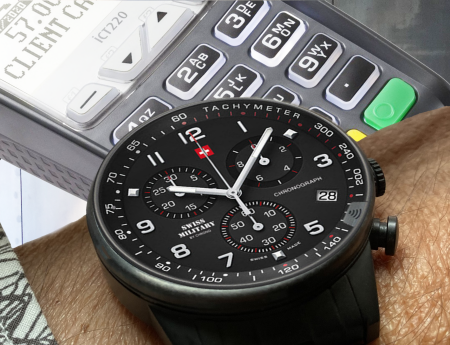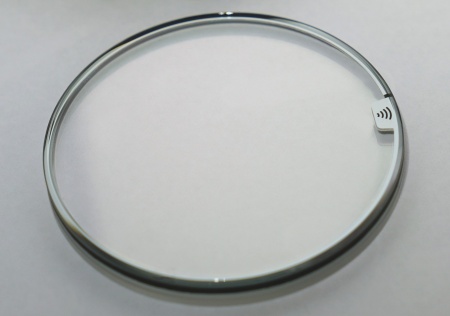Analog becomes smart. Sapphire crystal with payment chip from Infineon turns every watch into a contactless payment device.
Key know-how from Graz enables smart wearables.
More and more people around the world are paying contactless because it's easy, fast and hygienic. Especially in the wake of the Corona pandemic, the acceptance and spread of the technology has accelerated significantly. In addition to ATM or credit cards, so-called wearables are also in high demand. For the first time, it is now possible to equip traditional wristwatches or luxury models made of metal with the contactless payment function. The Swiss company Winwatch integrates tiny security chips from Infineon almost invisibly into its patented sapphire crystal STISS® for this purpose. The chip enables fast and secured payment transactions by radio frequency within milliseconds.
"A fast and robust connection from the watch to the reader at the checkout is crucial for customer acceptance," says Alex Kalbermatten, CEO of Winwatch. "Infineon surpasses all other solutions currently available on the market in terms of wireless quality. For example, by integrating the contactless chip we were able to develop a sapphire crystal that turns every watch - from mechanical heirlooms to metal sports watches - into a contactless payment device. And all of this without a battery."
"Whether with a classic card, a fashion accessory such as a ring or smart wearables – chip innovations from Infineon combine the real and the digital world and enable simple, secured and hygienic payment transactions," says Stefan Rohringer, Head of the Infineon Development Center in Graz. "Especially in recent months this trend has intensified due to the Corona pandemic".
The contactless trend is increasing worldwide and in Austria
The most widely used contactless payment method is still the credit or debit card. According to ABI, already two thirds of all cards used today work contactless. Their share is expected to grow to more than 80 percent by 2025. The market researchers estimate another 1.9 billion contactless cards to be shipped in 2020 worldwide. The demand for wearables with a payment function is also growing continuously. According to a study more than 75 percent of all Mastercard transactions in Europe are now contactless. Payment transactions with smartphones and wearables have doubled within a year from seven to 14 percent. With its security and contactless expertise as well as energy-efficient chip design, Infineon plays a leading role in this growth market. "As a global competence center for contactless technologies, the Graz site makes a decisive contribution in this field from Austria," says Stefan Rohringer.
According to PSA Payment Services Austria GmbH, around 9.9 million of the total of 10 million ATM cards in Austria have an Infineon chip with Near Field Communication (NFC) function. Contactless payment via ATM card is now taken for granted by more than three quarters of all card users. In February 2020, the share of all contactless transactions with ATM cards had already reached 76 percent, and in May 2020 it increased again to around 78 percent. This means that 4 out of 5 transactions were already made contactless in May 2020. Overall, the number of contactless payments in Austria has risen by almost 50 percent since the beginning of the previous year: from around 32 to around 63 million transactions.
With a market share of more than 47 percent*, Infineon is the world's number 1 in payment chips for cards and the leader in contactless technologies. The semiconductor manufacturer operates its own competence center for contactless technologies in Graz.
Combination of chip technology, data security and antenna design
Contactless payment solutions require a triad of semiconductor technology, encryption and analog radio technology. Whether card, watch, ring or key fob, the integrated chip plays a central role.
It is a mini-computer measuring just a few square millimeters that initiates and controls all communication between the customer and the financial institute via a small antenna. Within around 200 milliseconds – the blink of a human eye – the chip proves the authenticity of the device with an individual signature and creates a cryptogram of card data, payment amount and place of payment. After successful verification, the bank confirms the payment to the reader.
Communication between the card or wearable and the reader is based on NFC technology. At a distance of two to ten centimeters, the chip uses only the energy field of the reader to calculate, encrypt and transmit the data.
Infineon Graz: Competence Center for Contactless Technologies
For more than 20 years, Infineon has operated a competence center for contactless technologies in Graz. Whether in the transmission standard Near Field Communication (NFC), in vehicle components for optical distance measurement or
in 3D image sensor chips - the worldwide competence center for contactless technologies drives innovations in security, mobility and the Internet of Things. These are prerequisites for the successful development of digital payment solutions, electronic ID documents, NFC tags and modern block chain applications. Innovations in antenna technology in particular make Infineon's chip solutions so unique and enable robust contactless data exchange despite disruptive material influences or unusual form factors. In payment applications, these include metal watches, heart-shaped jewelry or finger rings. But also exclusive cards made of platinum and new, environmentally friendly cards made of recycled plastic are now possible.
*ABI Payment and Banking Cards Secure IC Technologies Report March 2020
About Infineon Austria
Infineon Technologies Austria AG is a group subsidiary of Infineon Technologies AG, a world-leading provider of semiconductor solutions that make life easier, safer and greener. Microelectronics from Infineon reduce the energy consumption of consumer electronics, domestic appliances and industrial facilities. They make a major contribution to the convenience, security and sustainability of vehicles, and enable secure transactions in the Internet of Things.
Besides Germany, Infineon Austria is the only subsidiary within the group that pools competencies for research and development, production as well as global business responsibility. The head office is in Villach, with further branches in Graz, Klagenfurt, Linz and Vienna. With 4,201 employees from around 60 countries (including 1,813 in research and development), in the financial year 2018 (ending in September) the company achieved a turnover of € 2.9 billion. An R&D expense rate of €498 million makes Infineon Austria the strongest industrial research company in Austria.
Press Photos
-
 Chip innovations from Infineon combine the real and the digital world and enable simple, secured and hygienic payment transactions with smart wearables. © InfineonCCS_mobile_payment_smart_wearable_vending_machine_upper-body_2
Chip innovations from Infineon combine the real and the digital world and enable simple, secured and hygienic payment transactions with smart wearables. © InfineonCCS_mobile_payment_smart_wearable_vending_machine_upper-body_2PNG | 38.22 mb | 7360 x 4912 px
-
 The sapphire crystal with payment chip from Infineon turns every watch into a contactless payment device. ©WinwatchWatch with STISS Sapphire Crystal_©Winwatch
The sapphire crystal with payment chip from Infineon turns every watch into a contactless payment device. ©WinwatchWatch with STISS Sapphire Crystal_©WinwatchPNG | 3.74 mb | 2181 x 1673 px
-
 The tiny security chip from Infineon is integrated almost invisibly into the patented sapphire crystal STISS®. ©WinwatchSTISS Sapphire Crystal_©Winwatch
The tiny security chip from Infineon is integrated almost invisibly into the patented sapphire crystal STISS®. ©WinwatchSTISS Sapphire Crystal_©WinwatchJPG | 347 kb | 2245 x 1575 px
-
 Whether with a classic card, a fashion accessory such as a ring or smart wearables – chip innovations from Infineon combine the real and the digital world and enable simple, secured and hygienic payment transactions. © InfineonKontaktlos Bezahlen_Karte_©Infineon.tif
Whether with a classic card, a fashion accessory such as a ring or smart wearables – chip innovations from Infineon combine the real and the digital world and enable simple, secured and hygienic payment transactions. © InfineonKontaktlos Bezahlen_Karte_©Infineon.tifPNG | 7.02 mb | 1500 x 1000 px
-

